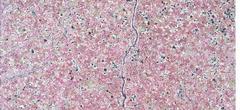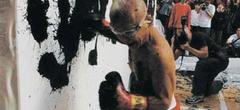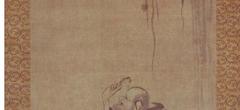Search
-

The Hudson (Detail)
ResourceThe artist who created this work, Junko Yoda, moved to New York City from Japan around 1966 when she was in her early 20s. She painted this aerial view of the Hudson River much later (2006) in response to flying over Ithaca & the Finger Lakes.
-

Community Identity?
LessonBy comparing "The Boxing Papers (Shinohara B)" by Kunie Sugiura and a scene from "Boxing Painting" by Ushio Shinohara, students will expand their knowlege of different artistic techniques while analyzing the concept of "community."
-

Defining "Home"
Lesson"Rocking Chair and Window" by Mayumi Terada and "Untitled" by Satoru Eguchi are used as a basis to start discussion about the definition of "home."
-

The Boxing Papers (Shinohara B)
ResourceFor her series "The Artist Papers," artist Kunie Sugiura chose as her subjects visual artists in various media who are current or former residents of New York City. These portraits capture images of these artists, often with an iconic, identifying element. The subject of the particular work shown here is artist Ushio Shinohara.
-

Rocking Chair and Window
ResourceTo create this piece, artist Mayumi Terada sculpted a small model of a room and then photographed it. Her haunting scene contains no human figures, yet their presence is implied.
-

Scene from Boxing Painting
ResourceThis is a photograph of a performance by artist Ushio Shinohara, which took place in New York City in 2006. During part of this performance, Shinohara created a painting in a style he invented called “Boxing Painting.” In this method of applying color to a surface, the artist wears boxing gloves, dips them in ink or paint and then punches paper or a canvas to create the painting.
-

Untitled
ResourceThe artist Satoru Eguchi created this model of his studio for the Japan Society gallery exhibition "Making a Home." Eguchi often creates sculptures or other works that are somewhere between the second and third dimensions; not quite flat, but not quite completed forms. His processes involve various explorations of the concepts of construction and deconstruction.
-

The Shrimp Eater
ResourceThis painting depicts the “Shrimp Eater,” one of a group of eccentric Buddhist saints with odd qualities.
-

The Four Gentlemanly Accomplishments
ResourceThe title of these panels, "The Four Gentlemanly Accomplishments," refers to four hobbies elite men were expected to practice in China beginning in the 8th century: calligraphy, painting, chess, and playing the qin. By the time these panels were painted, this tradition had made its way to Japan and the Japanese also began to value these skills.
-

Hotei
ResourceHotei was one of many Zen Buddhist “scattered saints,” eccentrics who likely originated as regional deities and were appropriated by Zen.
Displaying 141—150 of 443

